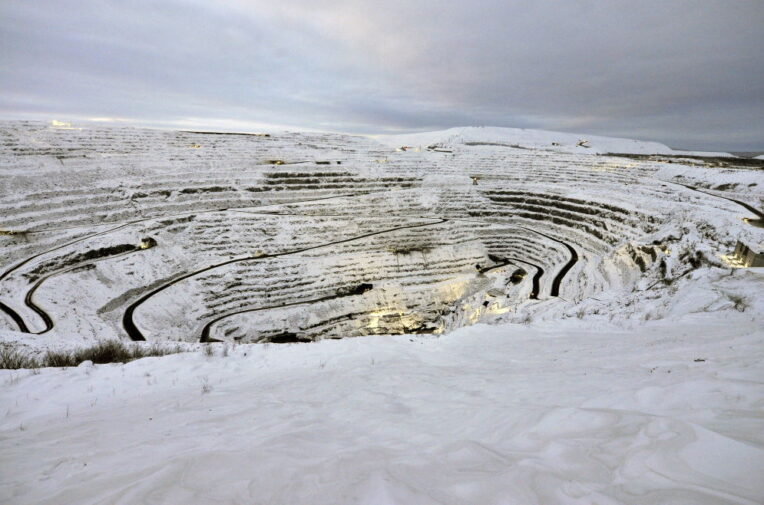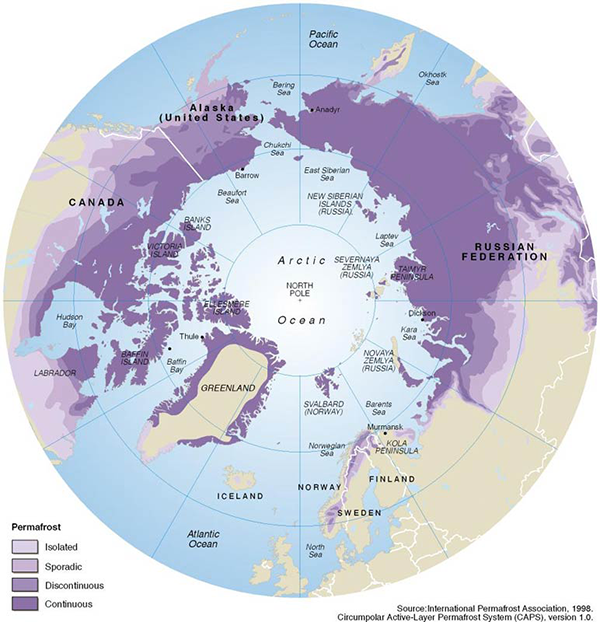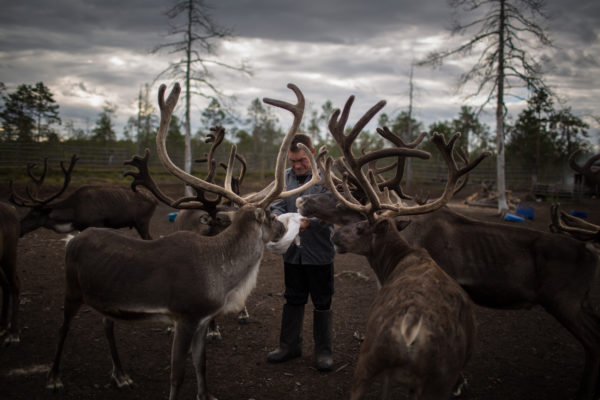25% van het noordelijk halfrond bestaat uit permafrost en dit ontdooit substantieel dus niet op de natuurlijke wijze die je 'normaal gesproken' zou kunnen verwachten.... Eén en ander gaat in een tempo dat de laatste 65 miljoen jaar niet eerder werd vertoond op de wereld, behalve dan met de meteoorinslag van 65 miljoen jaar geleden, al ging de klimaatverandering toen uiteraard in omgekeerde richting.......
Niet alleen komen er enorme hoeveelheden CO2 vrij bij het ontdooien van permafrost, maar ook gigantische hoeveelheden methaangas, een broeikasgas dat meer dan 80 keer zo sterk is dan CO2....... Wetenschappers zagen dat ontdooien wel aankomen, maar de situatie van dit moment hadden zij pas over 70 jaar verwacht........
In de IPCC berekeningen voor het (meer dan waardeloze en volkomen tekortschietende) klimaatakkoord van Parijs hebben niet eens rekening gehouden met het ontdooien van permafrost...... Het is dat 't zo triest is, anders zou je je werkelijk doodlachen, wat een krukken!! (en voor dit soort akkoorden worden nog eens enorme hoeveelheden CO2 geproduceerd, daar bezoekers per vliegtuig afreizen naar deze klimaattoppen...) Om het volk te laten zien dat het klimaat hen ernst is reisden Nederlandse politici per trein af naar Parijs, echter wat betreft daden die er toe doen blijft men hier (en elders) volledig nalatig, zie de stikstofdiscussie, er is amper een varkensboer gestopt en het krachtvoer, bestaande uit gentech soja verbouwd in Brazilië op gebieden die eerder bestonden uit oerwoud (dat daarvoor werd verbrand), mag gewoon worden gegeven aan de belachelijk grote Nederlandse veestapel.......
Wat dat betreft mogen we blij zijn met het Coronavirus, wat altijd voor onmogelijk werd gehouden is nu plotseling toch mogelijk en 2020 zal het jaar zijn dat er door industrie, energiecentrales en vooral door autoverkeer veel minder CO2 zal zijn geproduceerd.....
Lullig dan dat de enorme bosbranden, zoals die in Brazilië, om daar zoals gezegd bijvoorbeeld soja te verbouwen voor de Nederlandse veestapel, letterlijk roet in het eten gooien, al zou het zonder Corona nog veel erger zijn.....
Lees het
volgende verontrustende artikel en geeft het door, de hoogste tijd
dat iedereen wakker wordt!! (en vergeet niet dat we de klimaatverandering niet kunnen stoppen, zoals velen je willen doen geloven, we kunnen en moeten deze verandering voor de komende generaties en voor de diersoorten op aarde proberen af te remmen!!)
Het volgende artikel werd geschreven door Robert Hunziker en overgenomen van CounterPunch:
October 20, 2020
Large-Scale Permafrost Thawing
Twenty-five percent (25%) of the Northern Hemisphere is permafrost. By all appearances, it is melting well beyond natural background rates, in fact, substantially!
Making matters much, much worse, new research has identified past warming events of large-scale permafrost thaw in the Arctic that may be analogous to today, thus spotting a parallel problem of large-scale thawing accompanied by massively excessive carbon emissions spewing into the atmosphere, like there’s no tomorrow. (Source: Jannik Martens, Remobilization of Dormant Carbon From Siberian-Arctic Permafrost During Three Past Warming Events, Science Advances, vol. 6, no. 42, October 16, 2020)
Permafrost thawing is not, at all times, simply “thawing.” Of course, as a standalone, the word “thawing” implies a rather evenly keeled methodical process without any specific definition of scale. But, there’s thawing, and then, there’s “large-scale thawing,” which is kinda like turning loose a behemoth. The results are never pretty.
As global warming powers up, like its doing now, it has a penchant for finding enormous spans of frozen mud and silt filled with iced-species in quasi-permanent frozen states known as permafrost. As it melts, it’s full of surprises, some interesting, as well as some that are horribly dangerous, for example, emitting huge quantities of carbon, thus kicking into high gear some level of runaway global warming that threatens to wipeout agriculture.
As a matter of fact, according to the research, no more than a few degrees of warming, only a few, can trigger abrupt thaws of vast frozen land thereby releasing vast quantities of greenhouse gases as a product of collapsing landscapes, and it feeds upon itself. Indeed, the research effort identified “surges in greenhouse gas emissions… on a massive scale,” Ibid.
The study suggests that massive permafrost ecosystem thawing is subject to indeterminate timing sequences, but it’s armed with a “sensitive trigger” abruptly altering the landscape in massive fashion. In short, an event could arise out of the blue. It’s well known that Arctic permafrost holds considerably more carbon captured in a frozen state than has already been emitted into the atmosphere.
Already, over just the past two years, other field studies have shown instances where thawing permafrost is 70 years ahead of scientists’ models, prompting the thought that thawing may be cranking up even as the Intergovernmental Panel on Climate Change (IPCC) fails to anticipate it.
After all, permafrost is not included in the IPCC’s carbon budget, meaning signatories to the Paris accord of 2015 will need to recalculate their quest to save the world from too much carbon emitting too fast for any kind of smooth functionality of the planet’s climate system. In turn, it undoubtedly negatively impacts the support, or lack thereof, for food-growing regions, which could actually collapse, similar to cascading dominos. Poof!
In the Canadian High Arctic: “Observed maximum thaw depths at our sites are already exceeding those projected to occur by 2090.” (Source: Louise M. Farquharson et al, Climate Change Drives Widespread and Rapid Thermokarst Development in Very Cold Permafrost in the Canadian High Arctic, Geophysical Research Letters, June 10, 2019)
According to Susan Natali of Woods Hole Research Center (Massachusetts) the Arctic has already transformed from a carbon sink to a carbon emitter: “Given that the Arctic has been taking up carbon for tens of thousands of years, this shift to a carbon source is important because it highlights a new dynamic in the functioning of the Earth System.” (Source: Thawing Permafrost Has Turned the Arctic Into a Carbon Emitter, NewScientist, Oct. 21, 2019)
A 14-year study referenced by Dr. Natali shows annualized 1.66 gigatonnes CO2 emitted from the Arctic versus 1.03 gigatonnes absorbed, a major turning point in paleoclimate history, a chilling turn for the worse that threatens 10,000 years of our wonderful Holocene era “not too hot, not too cold.” Alas, that spectacular Goldilocks life of perfection is rapidly becoming a remembrance of the past.
Additionally, according to Vladimir Romanovsky – Permafrost Laboratory, Geophysical Institute, University of Alaska, Fairbanks (UAF) there are definitive geophysical signs of permafrost that survived thousands of years now starting to thaw. (Source: New Climate Warnings in Old Permafrost: ‘It’s a Little Scary Because it’s Happening Under Our Feet,’ Bob Berwyn, Inside Climate News, October 16, 2020)
As stated by Romanovsky: “The new (Jannik Martens, Remobilization) research is yet more evidence that the amplified warming in the Arctic can release carbon at a massive scale.”
Nobody knows how soon such an event will break loose in earnest, but global warming has already penetrated the upper permafrost layers, as cliffs of coastal permafrost are collapsing at an accelerating rate. In short, the current news about thawing/collapsing permafrost is decidedly negative and a threat to life, as we know it.
The Martens’ study conclusively states: “The results from this study on large-scale OC remobilization from permafrost are consistent with a growing set of observational records from the Arctic Ocean and provide support for modeling studies that simulated large injections of CO2 into the atmosphere during deglaciation (14–16). This demonstrates that Arctic warming by only a few degrees may suffice to abruptly activate large-scale permafrost thawing, indicating a sensitive trigger for a threshold-like permafrost climate change feedback.” (Jannik Martens, Remobilization)
Thus, as the Holocene era wanes right before humanity’s eyes, the Anthropocene, the age of humans, stands on the world stage all alone with its own shadow and with ever fewer, and fewer, and fewer vertebrates roaming amongst fields of scorched, blackened plant life. What, or who, will it eat?
According to the Pulitzer Prize-winning author and world-renowned biologist E.O. Wilson: If we choose the path of destruction, the planet will continue to descend irreversibly into the Anthropocene Epoch, the biologically final age in which the planet exists almost exclusively by, for, and of ourselves.
Robert Hunziker lives in Los Angeles and can be reached at rlhunziker@gmail.com.
==============================================
Zie ook: 'Uitstoot methaangas op hoogste punt sinds men begon met metingen in 1983'
'De stijging van de zeespiegel (en de opwarming van de aarde) gaat veel verder dan het IPCC voorspelt'
'Stikstof: de feiten op een rij' (en zie de links in dat bericht naar meer artikelen over het stikstofprobleem)
'Aantal CO2 deeltjes in de atmosfeer op voor de mens nooit eerder vertoond hoog niveau'
'Opwarming van Arctisch gebied laat besmettelijke ziekten vrijkomen uit de permafrost'
''Methaangasboer' ontsnappend uit de Oost-Arctische Plaat kan de wereld zoals wij die kennen vernietigen' (en zie de links in dat bericht)
'The Siberian plague' (ondanks het onderwerp met prachtige foto's)
'Hittegolf in Siberië: binnen de poolcirkel 38 graden Celsius'
'Siberië kampt al maanden met uitzonderlijk hoge temperaturen: "25,4graden, terwijl het gemiddeld 0 graden is"'
'Niet
eerder getoonde satellietfoto's laten zien dat grote delen van Arctisch
gebied in brand staan >> klimaatkantelpunt gepasseerd' (!!!!) (zie ook de links in dat bericht)
'Grote Arctische gebieden in Siberië, Groenland, Canada en Alaska branden: klimaatkantelpunt nadert met rasse schreden'
'Klimaatverandering: inwoners Bratsk (Siberië) stikken in de rook van bosbranden.......'
Wildfires
Increasingly Consuming Siberian Forests, Scientists Warn
''Klimaatakkoord'
>> Stientje van Veldhoven (D66 staatssecretaris) lult zich weer
eens 'groen' en verdedigt het niet extra belasten van benzine
auto's......'
'Klimaatakkoord >> Rutte: er komt 'een verstandige CO2 heffing' voor bedrijven.... ha! ha! ha! ha! ha! ha! ha!'
'Nederlandse lucht nog vuiler dan eerder gedacht.....'
'Longartsen tegen gebruik van dieselbrandstof'



